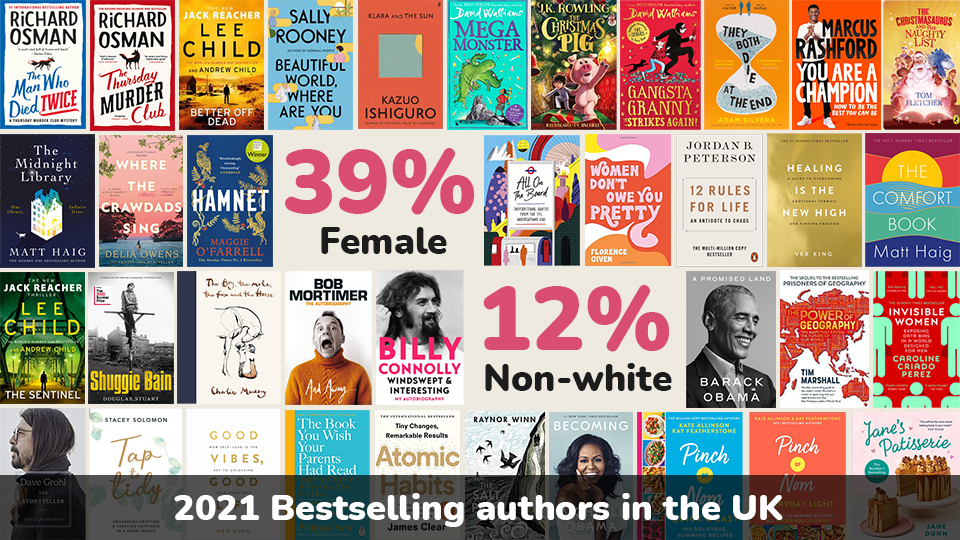The books we buy are a window into our society’s norms and beliefs. The book choices you and I make offer a glimpse into our souls. In a December 2021 article in The Sunday Times, Andrew Holgate examined 2021’s best-selling books in the UK. His conclusion was that our choices make for “chastening reading” because our preferences have veered towards escapist light reads rather than serious literature, politics or current affairs. The book market has grown during the pandemic, mainly due to consumers buying more fiction (crime and romance in particular). But book sales for politics and current affairs titles have declined by a remarkable third. In the non-fiction category, macro-scanning “brain stretchers” like Yuval Noah Harari’s Sapiens have given way to books focusing on the micro, such as family and self-improvement (e.g. Vex King) or alternative therapies (e.g. Bessel van der Kolk).
Having studied the top 10 bestseller lists in 8 categories also published in the 26 th December 2021 edition of The Sunday Times, I too have concluded that our choices of books in 2021 make for chastening reading, but for very different reasons to the ones outlined by Andrew Holgate. To my mind, our book preferences in 2021 reflect a gendered and somewhat racially segregated society.
Last year readers of all genders chose to buy books written more by men (61%) than by women authors, with most authors (88%) being white. The average representation of authors of colour across all categories in our book purchases was below the representation of people of colour in UK society: approximately 17% of the population is not white vs. 12% of the top 10 bestselling authors across the 8 categories. Bestselling authors of colour are particularly under-represented in fiction books. However, there is some good news too: the proportion of bestselling authors of colour is higher than that of the population in the categories of politics and current affairs, as well as in self- help and popular psychology books. This may be reflecting a heightened sensitivity to the systemic racism the pandemic has exposed so acutely in the last two years.

Are the patriarchal norms changing more slowly in society than in the publishing industry? Closer examination reveals that the answer is perhaps yes and no. In 2020, 57% of hardback and 62% of paperback fiction books were authored by women which is fantastic news for spearheading the previously muted voices of women writers. Nonetheless, the top 10 bestseller lists still expose a pronounced male bias in our consumer choices of authors. In 2021, only 18% of the hardback fiction and 45% of the paperback fiction bestsellers we bought were written by women.
When we take a step back and look at the gender composition of bestselling authors within different categories, we quickly recognise a traditional patriarchal picture familiar to us all. The proportion of women authors is by far the highest in the cookbooks category and is much lower in politics and current affairs. In self-help and psychology, where women are generally more likely to make up the readership, nevertheless it is books written by men rather than women that enjoy considerably more success.
It worries me when I see that our children are much more likely to consume books written by men. It increases the risk of us - through our choices - perpetuating and cementing a more white-male-dominated world lens for our offspring; of institutionalising even an exclusively male outlook on the world. Let us take an example from Bessel van der Kolk’s hugely popular “The Body Keeps the Score”, which featured in Andrew Holgate’s Sunday Times article. As I started reading his book during the Christmas holidays, I was struck by van der Kolk’s warped framing of violence against women. He writes that almost a third of couples “engage in violence” at some point in their relationship. I found this formulation both offensive and preposterous as in the vast majority of cases, women are on the receiving end of men’s violence. They are not “engaging in” it but are victims of it. I am fully convinced that given the choice, the overwhelming majority of women, if not all, when faced with the prospect of “engaging in” violence within their couple, would pass on it.

So, I am wondering whether next time we buy a book for ourselves or for our children we could ask ourselves whether the perspectives reflected in our book choices are diverse enough. Do we give women, authors of colour and authors of other genders the chance to help us craft our and our children’s views of the world? Or do we recreate an all-too-familiar biased world, favouring the perspectives of white men over everyone else’s? Can we challenge our own biases by reaching for books that we would not typically turn to? Making more consciously diverse choices would certainly help us secure more breathing space in an increasingly claustrophobic world of siloed ideologies, cultural wars, cancelled public figures and crumbled bridges.






